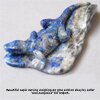 The name lapis lazuli is derived from a Latin word ‘Lauzulus’ that means blue stone. Its name may also have an early influence from the Persian word ‘Lazhuward’ and the Arabic word ‘Lazaward’, both of which mean blue.
The name lapis lazuli is derived from a Latin word ‘Lauzulus’ that means blue stone. Its name may also have an early influence from the Persian word ‘Lazhuward’ and the Arabic word ‘Lazaward’, both of which mean blue.
The relation between this intense natural blue gem and man goes way back 6500 years in history. The Egyptians have known to use this gemstone as early as the 3100 B.C. in inlay work, as beads and in lapis pendants. Natural lapis was also used as grounded power in medicines and as eye shadow in cosmetics. The Medieval builders used it in inlay work and mosaics that were created on the walls in their cathedrals. Renaissance painters used it to make an expensive ‘ultramarine’ natural blue color that was used in painting. This was done to give brightness and stability to the pictures.
The Buddhists believed that this gem brought peace of mind and tranquility. Some Greeks believed that the lapis stones could be used as an antidote to poisonous snakebites. In the middle ages, however, the lapis lazuli was used as a cure for fever.
 Composition of Blue Lapis
Composition of Blue LapisLapis lazuli is actually a rock that contains a number of minerals like lazurite, hauynite, sodalite, noselite. It also has varying amounts of pyrite and white calcite mineral in a vein-like pattern. The specific gravity ranges between 2.7 and 2.9. The average refractive index of this gemstone is 1.50 and the hardness on Mohs scale is 5.5. If a drop of hydrochloric acid is dropped on the gem, there is a reaction that results in a rotten egg smell.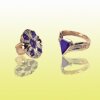
Lapis Lazuli Color
The lapis lazuli gem is found in various colors like blue, greenish and purple blue. However the most valuable color of lapis is the intense violet-blue without any white sodalite or calcite crystals in it.
 Cut
Cut
The blue lapis lazuli is usually carved for various artifacts. It is also cut in the cabochon cut for use in lapis jewelry like lapis rings, lapis earrings, lapis lazuli necklaces and more. Thin slabs of lapis rough are often polished and use in jewelry with its crude shape to give a designer look to the jewelry. The blue lapis necklace or the lapis lazuli choker is one of the favorite lapis lazuli jewelry pieces in India.
Carat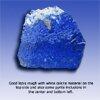
Lapis lazuli is available in large sizes. It is also abundantly available and therefore creatively used as lapis carvings. Big carvings are usually not sold in the market by weight but more by its size and quality of work done.
Clarity
The inclusions found in the lapis lazuli gem are generally made of pyrite, calcite and iron.
 Price, cost and Buying of Lapis Lazuli
Price, cost and Buying of Lapis LazuliThe most priced top-grade natural lapis are those which are violet blue and those that contain minimal or no trace of sodalite (white colored inclusions). On the other hand the presence of golden streaks due to the brilliant golden pyrite in a lapis increases the value of lapis lazuli further more. In general lapis lazuli price can range from 2$ to $50 per gram. 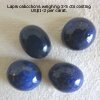
Lapis lazuli beads are often stringed together and worn as a bead necklace. It is a very popular gem that is used in men’s jewelry especially in sterling silver. Men’s lapis rings made in silver gives a very rich look.
 Markets and Producers
Markets and ProducersThe lapis lazuli mineral is a difficult gem to mine because it is typically found in risky terrains of Afghanistan valley. Top-grade deep blue rough lapis is found in Badakhshan mines of Afghanistan in large quantities. This gem was an important source of money for the Afghans during the Soviet war. It has been such an important gem for this country that it has been associated with the country’s economic policies. Other major deposits of this gem are found in Chile and Russia. Lapis rough are also mined in Angola, Mongolia, California, Canada, Burma and Pakistan.
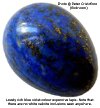
There are various treatments that are carried out on this gemstone. These are dying, waxing oiling and plastic impregnation that gives it a polished look. Out of these, dying is the most common treatment. Dying enhances the color of the gem temporarily. The color can actually come off when the gem is rubbed with a nail polish remover. The effect caused by waxing and oiling treatments can deteriorate when the gem is exposed to heat or sunlight. Since the practice of treating a lapis lazuli to get the deep blue natural hue is fairly common, it is always advisable to get the gem tested from a reputed gemological laboratory before actually making the purchase.
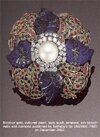 Simulants
SimulantsDue to the popularity of the gem there are a number of imitations of lapis lazuli like the Swiss lapis or German lapis, which is a type of jasper stained blue by the action of potassium ferro cyanide and ferrous sulphate.
Other common gemstones which are sold in the market as lapis are synthetic sintered spinel produced in Germany, paste (or glass) with spangles of copper crystal inclusions, sodalite and blue dyed chalcedony. In Ancient Egypt blue lapis imitations were colored with copper sulfate to achieve the special deep blue color.
 Synthetic Lapis Lazuli
Synthetic Lapis LazuliDue to the high demand and low supply of fine quality rough many manufacturers have tried to synthesize this beautiful gemstone. In more recent times, Gilson (a company that produces synthetic gemstones) has produced synthetic lapis lazuli gemstones. The synthetic Gilson lapis stones are however, more porous and low in hardness as compared to the natural ones and therefore not very popular as imitation to its natural counterpart.
 Interesting Trivia and other Lapis facts
Interesting Trivia and other Lapis factsLapis lazuli was venerated by the ancient Egyptians and was used for religious carvings. The gem was often worn by royalty since it was considered to be a prized gem in Babylonia and Egypt.
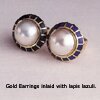 Reference
Reference1) Webster
2) Gemmology by Peter G.Read
3) Handbook of Gem Identification - Richard T.Liddicoat, jr
4) Gems and Crystals - From the American Museum of Natural History - Anna S.Sofianides and George E.Harlow.
Home | Add URL | About Us | Contact Us | Links | Privacy Policy | Resources | Sitemap | Design by Paper Tree
Copyright 2007 GehnaBazaar.com. All rights reserved. The information contained in this webpage may not be published, broadcast, rewritten or redistributed without a prior written consent. Natural Gemstones | Precious Gemstones | Jewellery Designers | Jewelry Institutes | Jewelery Design Institutes | Gemstone Information | Diamond Information | Gemmological Laboratories | Gem Labs | Jewelry Articles | Gold Price | Jewel Store | Buy and Sell Jewellery | Jewery Classes | Deisgn classes | Gemologists | Diamond Price